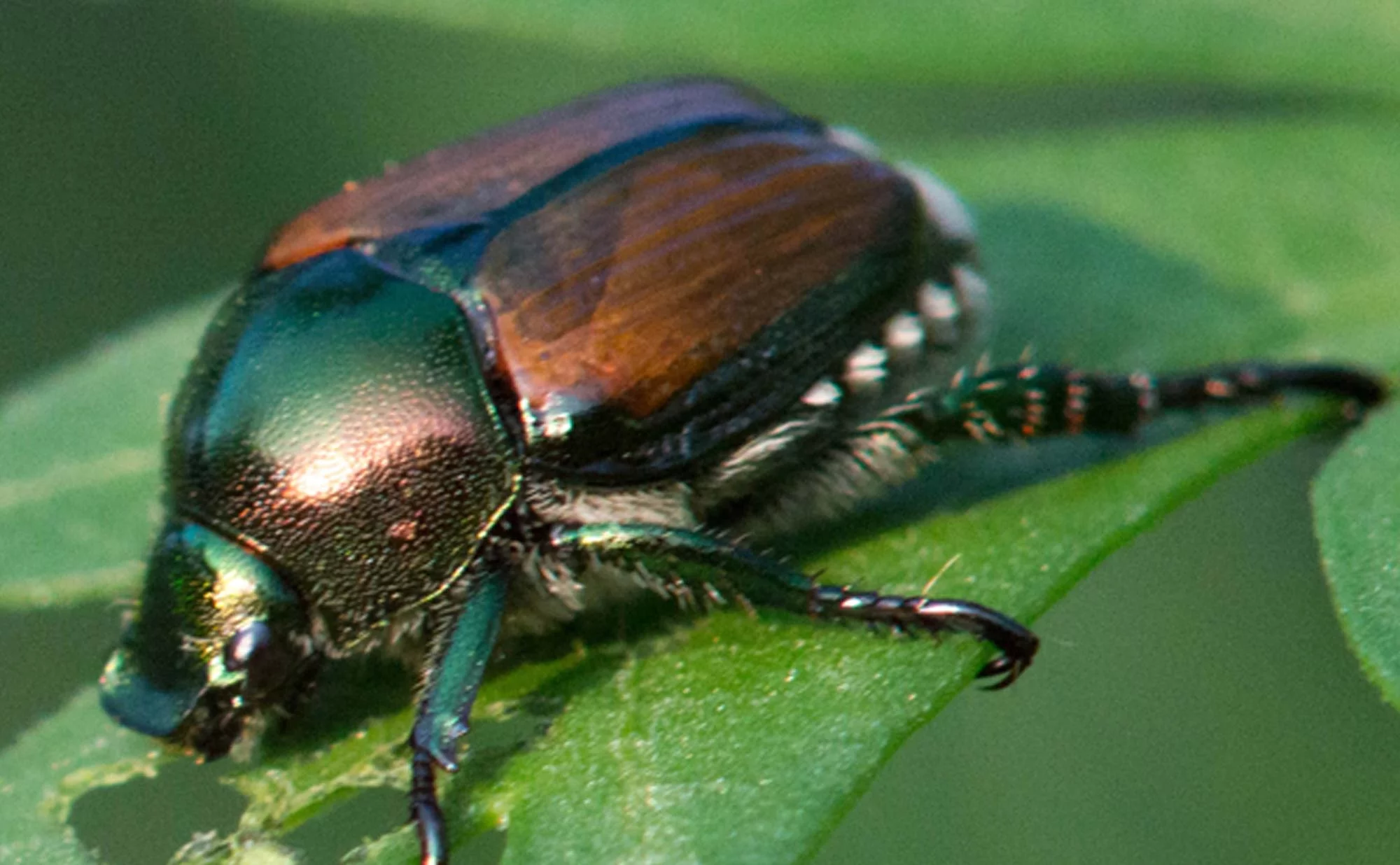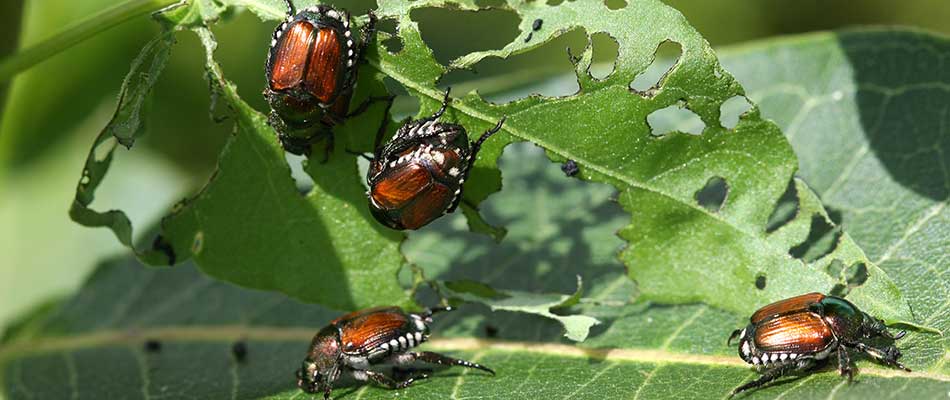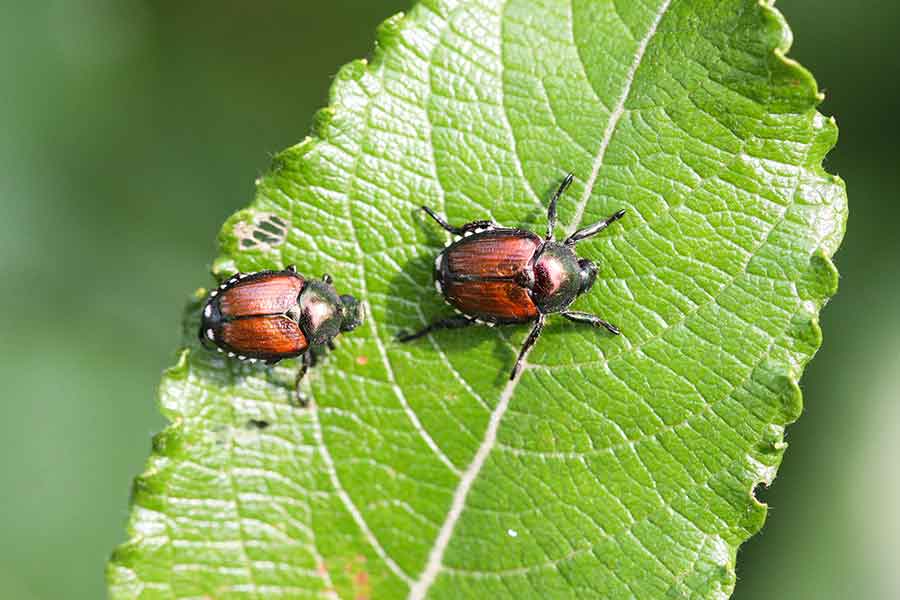japanese beetle life cycle iowa
The host range of this insect is very large over 300 species of plants. The beetle has six small tufts of white hair along the sides and back of its body under the edges of its wings.

Schedule My Japanese Beetle Treatment Today Rainbow Treecare
The life cycle of the Japanese beetle is typically one year in most parts of the United States but this can be extended in cooler climates.

. The head and thorax are shiny metallic green and the wing covers are coppery red. Life Cycle Injury Native to Japan the Japanese beetle was first introduced into the United States in 1916. Adult females lay eggs in moist sod in July.
Japanese beetle larva underground. As this insect moves into other areas its important to understand their life cycle the damage they cause and options for managing them. Some of the most common trees to suffer dieback from the Japanese Beetle in Des Moines Iowa are the River birch Betula nigra Paper birch Betula papyrifera Linden or American basswood Tilia americana and fruit trees.
After the egg hatches in summer the grub feeds on roots until the following summer when it emerges as a shiny beetle. Appearance of adult the timing of oviposition and subsequent development have been shown to vary with latitude altitude and also from year to year Fleming 1972. The best way to control adult beetles is to make a preemptive strike in the spring well in advance of the adults emerging.
Japanese beetle life cycle. Adult Japanese beetles feed on and damage some field crops ornamental plants shrubs and garden plants. Japanese beetle life cycle.
Life Cycle Japanese beetles have one generation per year in Iowa Fig. 2143 Grand Avenue Des Moines IA 50312 1-800-341-4769. Management of Japanese Beetle.
The Japanese beetle Popillia japonica has an annual life cycle. A female beetle lays 40 to 60 eggs during her lifetime. The Pesky Japanese Beetle.
In most parts of its range the Japanese beetle completes its life-cycle in one year but some populations in cooler climates may complete their development in two years Vittum 1986. Bagworms are caterpillars with a very unusual life-cycle. The Japanese beetle occurs in all states east of the Mississippi River with sporadic infestations reported in California Iowa Missouri and Nebraska.
Adults begin to emerge in May and feed on foliage through September. Females lay eggs in soil that hatch within seven. After the egg hatches in summer the grub feeds on roots until the following summer when it emerges as a shiny beetle.
50131 - Johnston Iowa. Adult Japanese beetles feed on and damage some field crops ornamental plants shrubs and garden plants. Adults begin emergence around 1030 degree days.
Japanese beetles are often found in field edges or areas of delayed growth. Japanese beetles have a. Females lay eggs in soil that hatch within seven to 14 days and grubs begin feeding on grass roots.
Adrian White is a certified herbalist who co-owns an Iowa organic farm specializing in organically grown produce and gourmet mushrooms. Japanese beetle larvae are annual white grubs. Here are the stages in the lifecycle of a Japanese beetle.
With course help online you pay for academic writing help and we give you a legal service. The host range of this insect is very large over 300 species of plants. While the adult life cycle of the Japanese Beetle is over at the end of the growing season it is always a good time to look ahead.
Life cycle of Japanese beetles. Please enter a valid location. They overwinter deep in the soil and resurface again in spring when soil temperatures rise to feed for another 3 to 4 weeks before emerging as adult Japanese beetles.
Some of the most common trees to suffer dieback from the Japanese Beetle in Des Moines Iowa are the River birch Betula nigra Paper birch Betula papyrifera Linden or American basswood Tilia americana and fruit trees. Japanese beetle have one generation per year Figure 2. The host range of this insect is very large over 300 species of plants.
Thats because much of its life cycle takes place underground. Adult female beetles lay eggs in the soil in early June. Thats because much of its life cycle takes place underground.
Life Cycle Japanese beetles have one generation per year in Iowa Photo 1. The Japanese beetle occurs in all states east ofthe Mississippi River with sporadic infestations reported in California Iowa Missouri and Nebraska. Its not easy to spot the Japanese beetle at first.
Corn soybean ornamentals fruit trees grapes weeds. Adults emerge from grass in late June and immediately begin to feed on low-lying plants such as roses and. The Japanese beetle has four life stages.
That is it takes one year to complete the development and growth from egg to adult and there is only one generation per year. A distinguishing feature of the beetles is five tufts of white. The grubs are C-shaped and approximately 125 inches when fully grown.
What is the life cycle of the Japanese beetle. Japanese beetles that were present last summer laid eggs in moist soil covered with grasses turfgrass waterways roadsides etc. After this spring feeding period during the third summer of its life cycle the grub.
Japanese beetles are similar to other Junebugs in appearance and 38 inch long and 14 inch wide. Adult Japanese beetles feed on and damage some field crops ornamental plants shrubs and garden. Growing degree days accumulated base 50F for Japanese beetle adults in Iowa 1 January-14 June 2015.
In Iowa adult beetles emerge in mid-June through July. The Japanese beetle did not appear in Iowa until 1994 but is now found in over 34ths of the state. Iowa Missouri and Nebraska.
Its not easy to spot the Japanese beetle at first. Life Cycle Injury Native to Japan the Japanese beetle was first introduced into the United States in 1916. Grubs cease feeding in October and overwinter 15 cm below the soil surface Figure 3.
How to Recognize the Japanese Beetles Life Stages. The males usually are. The adult Japanese beetle is a little less than half an inch long and has a shiny metallic-green body with bronze-colored outer wings.

Japanese Beetle Soybean Pest Soybean Research Information Network Srin

Japanese Beetle Control In Des Moines West Des Moines Ankeny Ia A Lawn Landscape

Bioluminescent Bugs Predatory Glow Worms Discovered In Rainforest Webecoist Incredible Creatures Glow Worm Species

Signs Of Japanese Beetle Infestations Shades Of Green Lawn Landscape

Japanese Beetle The Arbor Day Foundation

Japanese Beetle Soybean Pest Soybean Research Information Network Srin

Effective Management Remains Elusive For Beetle That Eats Almost Anything
Life Cycle Of The Japanese Beetle Including A Eggs David Cappaert Download Scientific Diagram

Japanese Beetle Control The Good Earth Garden Center

How To Get Rid Of Japanese Beetles In Your Yard

Japanese Beetles Emerging In Southern Iowa Integrated Crop Management

Japanese Beetles Begin Emergence Integrated Crop Management

No Easy Solution For Japanese Beetles Iowa Public Radio

Japanese Beetles Meadows Farms

How To Protect Your Trees And Shrubs From Japanese Beetles Lawn Care Blog Lawn Love

Information On The Beetle Life Cycle Terminix

How Many Japanese Beetles Will You See This Year Horticulture And Home Pest News

